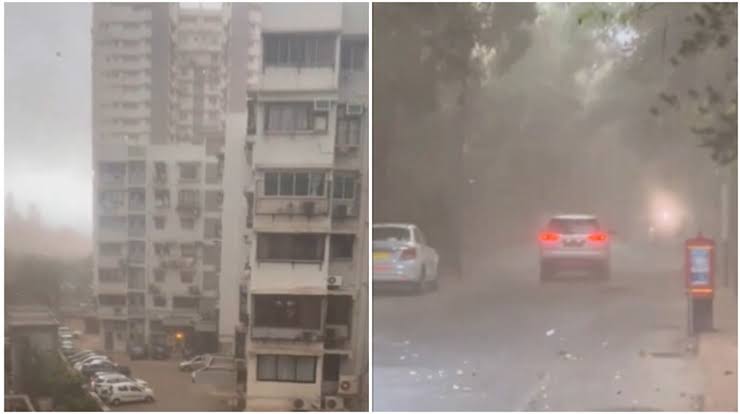Mumbai, often referred to as the financial capital of India, was met with an unusual weather phenomenon as a massive dust storm swept through the city, heralding the arrival of the season’s first rain. This extraordinary weather event not only brought relief from the scorching heat but also disrupted normal life, including affecting airport operations.
The Dust Storm:
The dust storm, characterized by strong winds carrying a vast amount of dust particles, descended upon Mumbai with little warning. The sky turned a shade of orange as the dust obscured visibility and created an eerie atmosphere across the city. Such storms are not uncommon in regions with arid climates, but their occurrence in a bustling metropolis like Mumbai is relatively rare.
Impact on Daily Life:
The sudden onset of the dust storm caught many residents off guard, leading to disruptions in daily routines. Visibility on roads plummeted, resulting in traffic congestion and delays in public transportation services. Pedestrians hurriedly sought shelter indoors to protect themselves from the dust-laden winds, while businesses and schools were forced to temporarily suspend their operations.
Airport Operations Affected:
One of the most significant consequences of the dust storm was its impact on Chhatrapati Shivaji Maharaj International Airport, Mumbai’s primary aviation hub. The reduced visibility and strong winds posed a challenge to flight operations, leading to the cancellation and diversion of several flights. Passengers were left stranded at the airport, grappling with uncertainty and frustration as they awaited updates on their travel arrangements.
Season’s First Rain:
Amidst the chaos caused by the dust storm, Mumbai received its first rainfall of the season, offering a reprieve from the oppressive heat that had engulfed the city in recent weeks. The gentle patter of raindrops provided a welcome respite and offered hope for a more temperate climate in the days to come. However, the rain was not without its own set of challenges, as it compounded the effects of the dust storm, creating muddy puddles and slippery surfaces on roads.
Response and Recovery Efforts:
In the aftermath of the dust storm and subsequent rainfall, local authorities sprang into action to assess the damage and restore normalcy. Cleanup crews were deployed to clear the streets of debris and dust, while efforts were made to ensure the safe resumption of airport operations. Additionally, measures were put in place to mitigate the impact of future dust storms and improve the city’s resilience to extreme weather events.
Conclusion:
The occurrence of a massive dust storm followed by the season’s first rain in Mumbai serves as a stark reminder of the unpredictable nature of weather patterns and the need for preparedness and resilience in urban environments. While such events may disrupt daily life and cause inconvenience, they also highlight the importance of proactive measures to mitigate their impact and ensure the safety and well-being of residents. As Mumbai continues to grapple with the challenges posed by extreme weather events, concerted efforts must be made to build a more resilient and sustainable city for the future.
